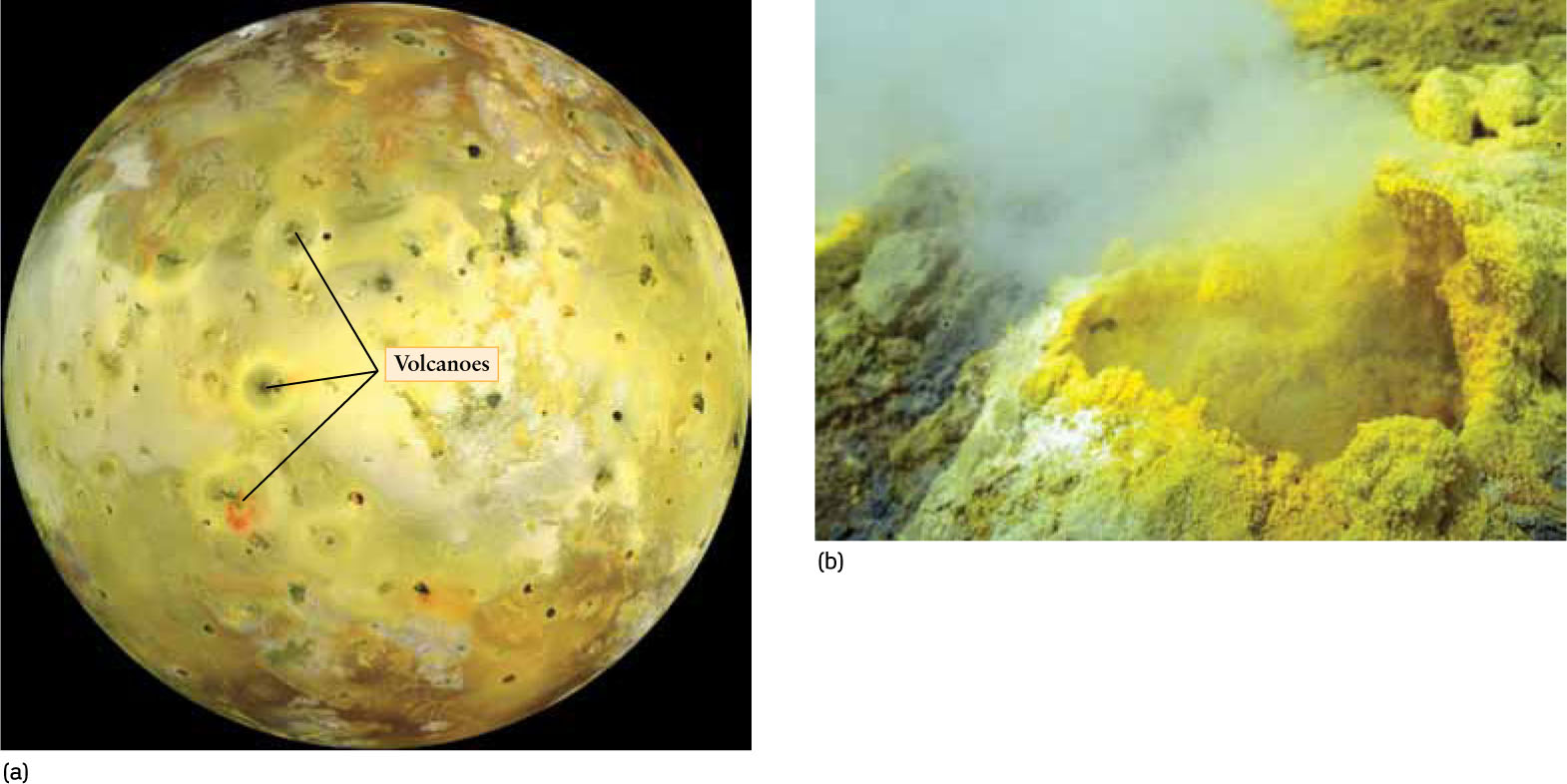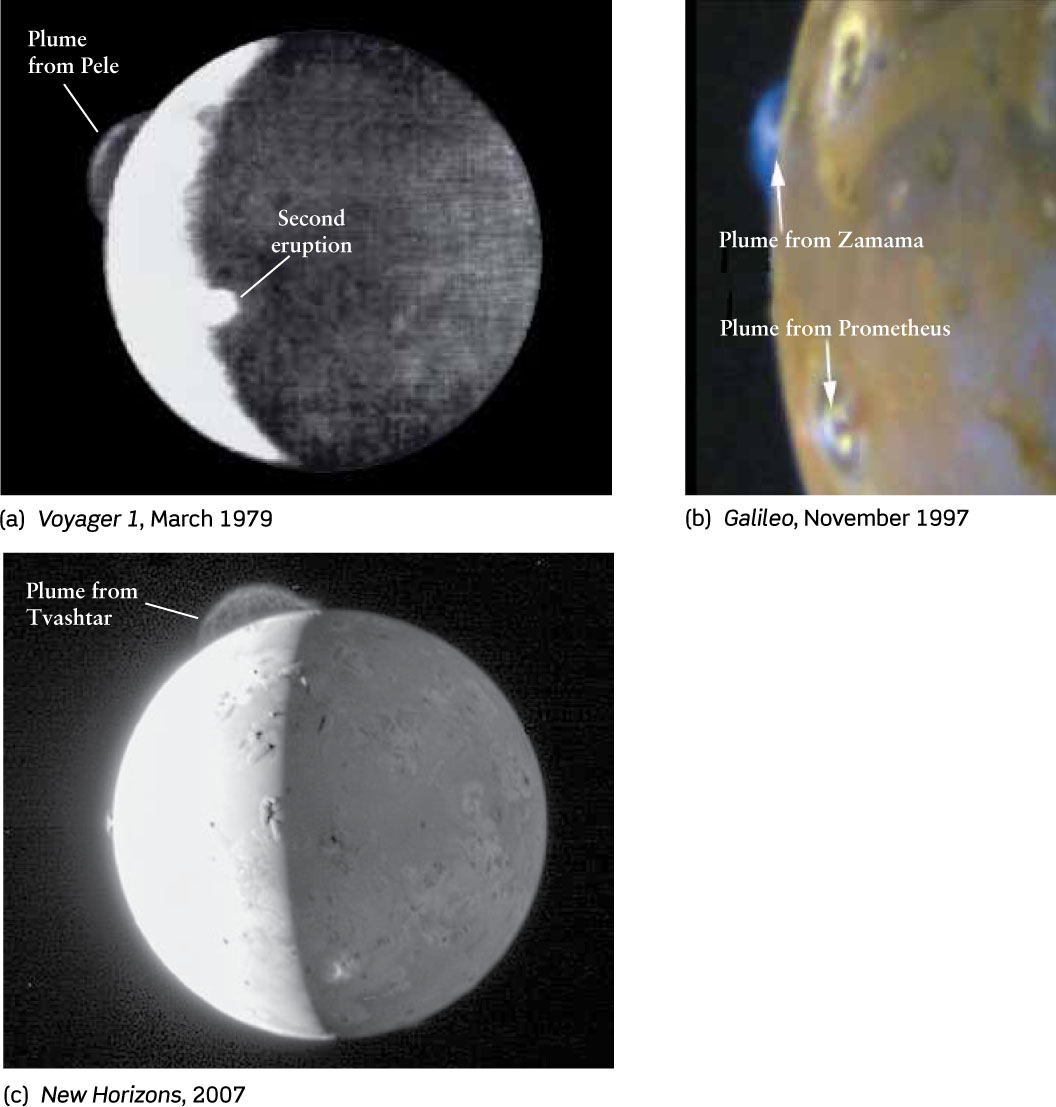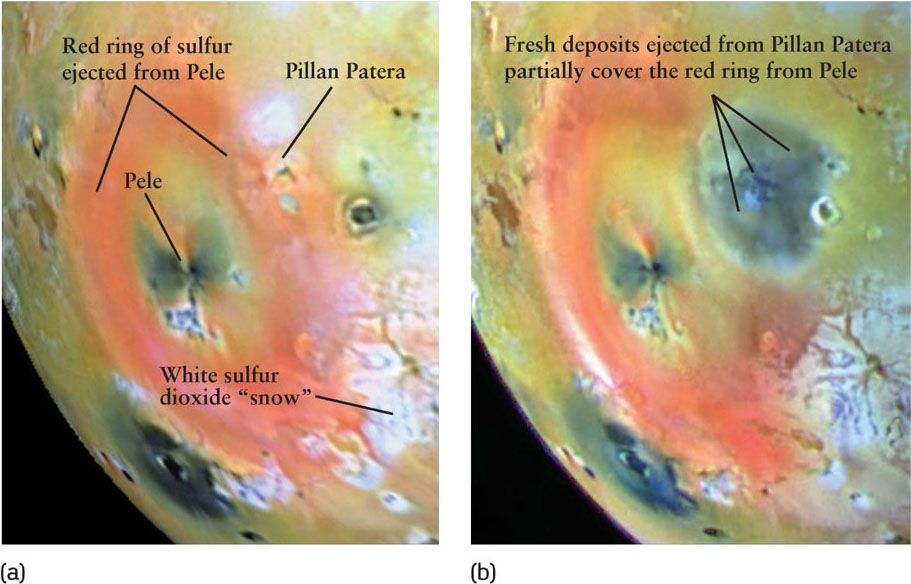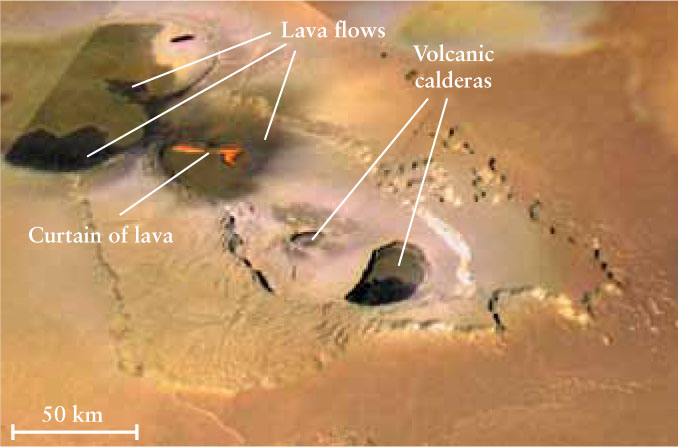13-4 Io is covered with colorful sulfur compounds ejected from active volcanoes
Before the two Voyager spacecraft flew past Jupiter, the nature of Io was largely unknown. On the basis of Io’s size and density, however, it was expected that Io would be a world much like our own Moon—geologically dead, with little internal heat available to power tectonic or volcanic activity (see Section 7-6). Therefore, it was thought that Io’s surface would be extensively cratered, because there would have been little geologic activity to erase those craters over the satellite’s history.
Io proved to be utterly different from these naive predictions, as you can see in Figure 13-4 and the opening figure of this chapter. For our first views, Voyager 1 came within 21,000 kilometers (13,000 miles) of Io and began sending back a series of bizarre and unexpected pictures of the satellite. These images showed that Io has no impact craters at all! Instead, the surface is pockmarked by irregularly shaped pits and is blotched with vibrant colors.

 R I V U X G
R I V U X GThe Colors of Io (a) This true-color image of Io shows a striking yellow surface. Numerous volcanoes dot Io’s surface, spewing out sulfur compounds. Sulfur (S) appears yellow, sulfur dioxide (SO2) appears white, and S3 and S4 appear red. (b) Here on Earth, we find yellow and white sulfur formations around volcanic vents.
The scientists were seeing confirmation of a prediction published in the journal Science just three days before Voyager 1 flew past Io in March 1979. In this article, Stanton Peale of the University of California, Santa Barbara, and Patrick Cassen and Ray Reynolds of NASA’s Ames Research Center reported their conclusion that Io’s interior must be kept hot by Jupiter’s tidal forces, and that this should lead to intense volcanic activity.
Tidal Heating on Io
The theory of tidal forces helped predict Io’s volcanic nature
As we saw in Section 4-8, tidal forces are differences in the gravitational pull on different parts of a planet or satellite. These forces tend to deform the shape of the planet or satellite (see Figure 4-28). Io, for example, is somewhat distorted from a spherical shape by tidal forces from Jupiter. If Io were in a perfectly circular orbit so that it traveled around Jupiter at a steady speed, Io’s rotation would always be in lockstep with its orbital motion. In this case, Io would be in perfect synchronous rotation, with its long axis always pointed directly toward Jupiter. But as Io moves around its orbit, Europa and Ganymede exert gravitational tugs on it in a regular, rhythmic fashion, thanks to the 1:2:4 ratio among the orbital periods of these three satellites. These tugs distort Io’s orbit into an ellipse, and so its speed varies as it moves around its orbit. Consequently, Io’s long axis “nods” back and forth by about ½° as seen from Jupiter. Due to this “nodding,” the tidal stresses that Jupiter exerts on Io vary rhythmically as Io moves around its orbit. These varying tidal stresses alternately squeeze and flex Io. Just as a ball of clay or bread dough gets warm as you knead it between your fingers, this squeezing and flexing causes tidal heating of Io’s interior. (Earth’s Moon also “nods” as it orbits our planet, but experiences almost no tidal heating because Earth’s tidal forces are very weak compared to those of massive Jupiter.)
356
Tidal heating adds energy to Io at a rate of about 1014 watts, equivalent to 24 tons of TNT exploding every second. As this energy makes its way to the satellite’s surface, it provides about 2.5 watts of power to each square meter of Io’s surface. By comparison, the average global heat flow through Earth’s crust is 0.06 watts per square meter. Only in volcanically active areas on Earth do we find heat flows that even come close to Io’s average. Thus, Peale, Cassen, and Reynolds predicted “widespread and recurrent surface volcanism” on Io.
Io’s Active Volcanoes
No one expected that Voyager 1 would obtain images of erupting volcanoes on Io. After all, a spacecraft making a single trip past Earth would be highly unlikely to catch a large volcano actually erupting. But, in fact, Voyager 1 images of Io revealed eight different giant plumes of gas from volcanic eruptions. (Figure 13-5a shows two of these.) More recently, the Galileo and New Horizons spacecraft returned detailed images of several such plumes (Figure 13-5b, c). These observations resoundingly confirm the Peale-Cassen-Reynolds prediction: Io is by far the most volcanic world in the solar system.

Volcanic Plumes on Io (a) Io’s volcanic eruptions were first discovered on this Voyager 1 image. The plume at upper left, which extends 260 km (150 mi) above Io’s surface, came from the volcano Pele. (b) This Galileo image shows plumes from the volcanoes Prometheus and Zamama. The plumes rise to about 100 km (60 mi) above Io’s surface and are about 250 km (150 mi) wide. (c) At the top of this New Horizons image, the plume from the volcano Tvashtar reaches 290 km high. Another plume is visible at the far left edge. The mountains near the center, just to the left of the terminator (the line between day and night) are about as tall as Mount Everest.
Io’s volcanic plumes rise to astonishing heights of 70 to 290 km above Io’s surface. To reach such altitudes, the material must emerge from volcanic vents with speeds between 300 and 1000 m/s (1100 to 3600 km/h, or 700 to 2200 mi/h). Even the most violent volcanoes on Earth have eruption speeds of only around 100 m/s (360 km/h, or 220 mi/h). Scientists thus began to suspect that Io’s volcanic activity must be fundamentally different from volcanism here on Earth.
The Nature of Io’s Volcanic Eruptions
An important clue about volcanism on Io came from the infrared spectrometers aboard Voyager 1, which detected abundant sulfur and sulfur dioxide in Io’s volcanic plumes. This observation led to the idea that the plumes are actually more like geysers than volcanic eruptions. In a geyser on Earth, water seeps down to volcanically heated rocks, where it changes to steam and erupts explosively through a vent. Planetary geologists Susan Kieffer, Eugene Shoemaker, and Bradford Smith suggested that sulfur dioxide rather than water could be the principal propulsive agent driving volcanic plumes on Io. Sulfur dioxide is a solid at the frigid temperatures found on most of Io’s surface, but it should be molten at depths of only a few kilometers. Just as the explosive conversion of water into steam produces a geyser on Earth, the conversion of liquid sulfur dioxide into a high-pressure gas could result in eruption velocities of up to 1000 m/s.
 Io’s dramatic coloration (see Figure 13-4) is probably due to sulfur and sulfur dioxide, which are ejected in volcanic plumes and later fall back to the surface. Sulfur is normally bright yellow, which explains the dominant color of Io’s surface. But if sulfur is heated and suddenly cooled, as would happen if it were ejected from a volcanic vent and allowed to fall to the surface, it can assume a range of colors from orange and red to black. Indeed, these colors are commonly found around active volcanic vents (Figure 13-6). Whitish surface deposits (examine Figure 13-4 and Figure 13-6a), by contrast, are probably due to sulfur dioxide (SO2). Volcanic vents on Earth commonly discharge SO2 in the form of an acrid gas. But on Io, when hot SO2 gas is released by an eruption into the cold vacuum of space, it crystallizes into white snowflakes. This sulfur dioxide “snow” then falls back down onto Io’s surface.
Io’s dramatic coloration (see Figure 13-4) is probably due to sulfur and sulfur dioxide, which are ejected in volcanic plumes and later fall back to the surface. Sulfur is normally bright yellow, which explains the dominant color of Io’s surface. But if sulfur is heated and suddenly cooled, as would happen if it were ejected from a volcanic vent and allowed to fall to the surface, it can assume a range of colors from orange and red to black. Indeed, these colors are commonly found around active volcanic vents (Figure 13-6). Whitish surface deposits (examine Figure 13-4 and Figure 13-6a), by contrast, are probably due to sulfur dioxide (SO2). Volcanic vents on Earth commonly discharge SO2 in the form of an acrid gas. But on Io, when hot SO2 gas is released by an eruption into the cold vacuum of space, it crystallizes into white snowflakes. This sulfur dioxide “snow” then falls back down onto Io’s surface.

Rapid Changes on Io (a) This Galileo image shows a portion of Io’s southern hemisphere. Sulfur ejected from the active volcanic vent Pele produced a red ring that resembles paint sprayed from a can. (b) A few months later, a volcanic plume erupted from a vent called Pillan Patera, spraying dark material over an area some 400 km (250 mi) in diameter (about the size of Arizona). Other than Earth, Io is the only world in the solar system that shows such noticeable changes over short time spans.
357
358
The plumes are not the whole story of volcanism on Io, however. The sources of the plumes appear in Voyager images as black spots 10 to 50 km in diameter, which are actually volcanic vents (see Figure 13-4a). Many of these black spots, which cover 5 percent of Io’s surface, are surrounded by dark lava flows. Figure 13-7 is a Galileo image of one of Io’s most active volcanic regions, where in 1999 lava was found spouting to altitudes of thousands of meters along a fissure 40 km (25 mi) in length. The glow from this lava fountain was so intense that it was visible with Earth-based telescopes. Thus, Io has two distinct styles of volcanic activity: unique geyserlike plumes, and lava flows that are more dramatic versions of volcanic flows on Earth.

Io’s Glowing Volcanoes This false-color Galileo image (made while Io was in the darkness of Jupiter’s shadow) shows the infrared and visible glow from several volcanic regions, including Pele and Pillan (see Figure 13-6). These regions are substantially hotter than typical lava flows on Earth.

Io’s Lava Flows and a Curtain of Fire This mosaic of Galileo spacecraft images shows a nested chain of volcanic calderas (pits) with black lava flows. The red streak at upper left is a fissure in the surface about 40 km (25 mi) long, through which lava is erupting upward in a vertical sheet or curtain. The erupting lava reaches the amazing height of 1500 m (5000 ft).
While sulfur and sulfur compounds are the key constituents of Io’s volcanic plumes, the lava flows must be made of something else. Infrared measurements from the Galileo spacecraft (Figure 13-8) show that lava flows on Io are at temperatures of 1700 to 2000 K (about 1450 to 1750°C, or 2600 to 3150°F). At these temperatures sulfur could not remain molten but would evaporate almost instantly. Io’s lavas are also unlikely to have the same chemical composition as typical lavas on Earth, which have temperatures of only 1300 to 1450 K. Instead, lavas on Io are probably enriched in magnesium and iron, which give the lava a higher melting temperature.
Similar lavas enriched in magnesium and iron are found on Earth, but primarily in solidified lava beds that formed billions of years ago when Earth’s interior was much hotter than today. The presence of this enriched lava on Io suggests that its interior, too, is substantially hotter than that of the present-day Earth. One model proposes that Io has a 100-km (60-mi) thick crust floating atop a worldwide ocean of liquid magma 800 km (500 mi) deep. (As we saw in Section 9-2, the mantle that lies underneath Earth’s crust is a plastic solid rather than a true liquid.) The global extent of this “magma ocean” would explain why volcanic activity is found at all points on Io’s surface, rather than being concentrated in pockets as on Earth (see Section 9-3). It could also explain the origin of Io’s mountains, which reach heights up to 10 km (30,000 ft). In this model, these mountains are blocks of Io’s crust that have tilted before sinking into the depths of the magma ocean.
Io’s worldwide volcanic activity is remarkably persistent. When Voyager 2 flew through the Jovian system in July 1979, four months after Voyager 1, almost all of the volcanic plumes seen by Voyager 1 were still active. And when Galileo first viewed Io in 1996, about half of the volcanoes seen by the Voyager spacecraft were still ejecting material, while other, new volcanoes had become active.
Io may have as many as 425 active volcanoes, each of which ejects an estimated 10,000 tons of material per second. Altogether, volcanism on Io may eject as much as 1013 tons of matter each year. This amount of material is sufficient to cover the satellite’s entire surface to a depth of 1 meter in a century, or to cover an area of 1000 square kilometers in a few weeks (see Figure 13-6). Thanks to this continual “repaving” of the surface, there are probably no long-lived features on Io, and any impact craters are quickly covered up.
CONCEPT CHECK 13-4
The strongest tidal forces on Io are exerted by Jupiter. Then why are the orbital properties of Europa and Ganymede important for generating the heat that powers Io’s volcanism?
359